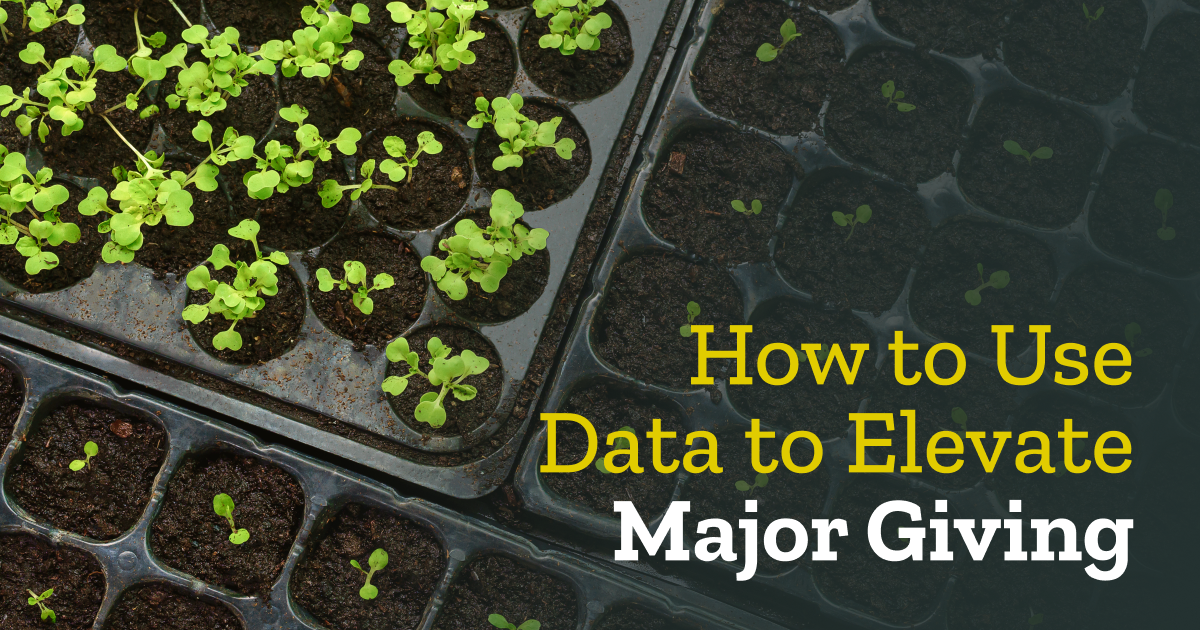Fundraising success depends on the ability to leverage two important assets: data and time. With improved data, you can spend your time—a precious resource—in the right places.
This is especially true when it comes to major gift fundraising.
Whether you aspire to elevate your major giving—or whether you’re building a major gifts program for the first time—consider the following guidelines.
1. Know where you have been.
Pull your performance activity from the last three years. This should include…
- Total dollars raised
- Total donors
- Number of major gift solicitations
- Number of major gifts received
- Total revenue from major gifts
- Total capacity of each portfolio (and if you do not have portfolios, begin by assessing the capacity of your top 100 to 200 prospects)
- Number of substantive contacts in each portfolio
If you cannot pull these data easily, it is time to evaluate your fundraising database practices and, potentially, consider replacing your CRM.
Visualize your data. Use it to answer the following questions.
- Are our portfolios appropriately sized?
- Do our managed prospects have the appropriate capacity and affinity to qualify being in a major gift portfolio?
- Are there promising prospects who are not in portfolios?
- Are our prospects actively engaged?
- Are we asking for the right amounts?
- Are we closing an appropriate number of gifts?
2. Decide where you want to go.
The process of answering these questions will help you understand who you have been, and it will create a framework for determining how you define success.
Next, hold a planning workshop with your team. Review the data and trends you discovered and decide—as a team—what you want to look like in three years. For each of the above questions, establish KPIs (Key Performance Indicators), then use those KPIs to determine strategies.
For example, if a KPI is to double the amount you raise in major gifts in the next three years, your strategies may include improving or replacing your CRM, performing a capacity assessment, increasing the number of prospects qualified, hiring a prospect researcher, adding major gifts staff…or perhaps partnering with Benefactor Group!
3. Plan for how you will get there.
Once you have set your three-year goal and established supporting strategies, it is time to create the plan. You may feel overwhelmed at first—it’s likely you’ve identified a number of strategies, each which will require time and effort and compete with your other priorities.
Acknowledging this, we recommend an agile approach. Instead of looking at this as a single, cohesive list— “eating the elephant in one bite”—begin first by committing to the overall vision. Once that is in place, prioritize the strategies you will implement in the next 90 days. If a strategy will take more than 90 days to complete, such as hiring a prospect researcher, break the recommendation into smaller components: writing the position profile, identifying candidates, and beginning to interview.
Assign an owner for each strategy. Check in frequently and learn as you go. At the conclusion of the 90 days, review your performance (you should complete at least 80% of the goals) and then plan the objectives for the next 90 days.
Remember—the most important step is to start.
4. Ensure your systems are up to the task.
You have the blueprint; now it’s time to “build your house.” The metrics you established will guide how to configure your CRM. For example, if you plan to measure portfolio penetration, you will need to make sure the CRM is configured to track actions and identify some as “substantive.” For some databases, this may mean rethinking (or beginning to think about!) the proper use of campaign, appeal, fund, prospect status, solicitation amount—the list goes on.
This process is akin to tailoring a suit to fit your measurements. You may also find your current suit no longer fits. If that is the case, you can use this process to define your database needs and find new technology.
5. Define and build reports and dashboards.
Winston Churchill said it best: “However beautiful the strategy, you should occasionally look at the results.” You’ve set your objectives, defined metrics, set up your systems, and tracked every touch point and gift. Now, you need to ask yourself and your systems: how are we doing? What questions do we need to answer to understand how we are doing? (Hint: look at the metrics and targets you set up in step two.) Define and create the reports, queries, and dashboards your team needs to access quick, concise answers. Run these reports regularly; use them as part of meetings and adjust your major giving strategies based on actual performance. Your data can offer valuable insights, but it does not accomplish anything if it never leaves your CRM.
6. Include the team.
Equip your team with the skills, training, and coaching necessary to use the systems and reports. Encourage and empower your team to enter the appropriate data into the system so the reports are accurate. Look at the reports and measures as levers (not cudgels) that will motivate your team. Continued coaching and support will ensure a productive and happy team.





